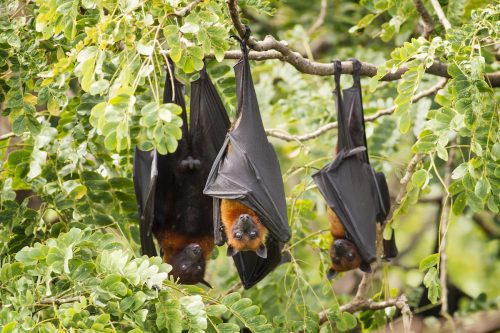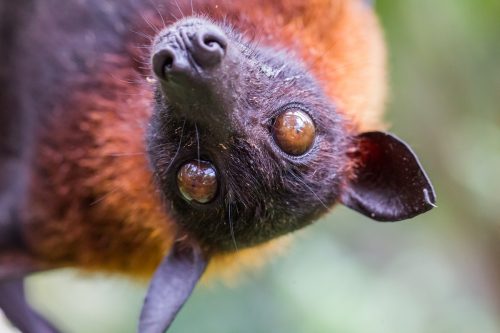Hungry “Megabats” Could Start the Next Pandemic, Researchers Have Discovered
The flying mammals could spread Hendra virus.

Scientists in Australia have identified an animal they suspect might be the source of the next big viral pandemic: Flying foxes, also known as “megabats.” The flying mammals, which have a wingspan as wide as three feet, tend to shed virus when they are hungry, a time when they venture close to humans and farm animals, the Telegraph reported. The scenario increases the chance of spillover events when viruses jump from animals to humans or other animals.
Experts believe the COVID pandemic began when the SARS-CoV-2 virus transferred from an animal to a human. In a recent study, scientists looked at Hendra virus, a rare respiratory disease carried by bats. The animals have a robust immune system that allows them to carry various dangerous viruses without being infected, including SARS and Marburg. Hendra is particularly dangerous—it kills 75 percent of horses who catch it and can also infect humans. Read on to learn more.
RELATED: The 10 Most “OMG” Science Discoveries of 2022

Hendra virus was first identified in Australia in 1994. In the first outbreak, two people contracted Hendra from horses. One, a stablehand, recovered; another, a 49-year-old horse trainer, died. In horses, Hendra symptoms include nasal discharge, fever, difficulty breathing, and neurological issues like compulsively drinking water or bashing themselves against their stables.
Since then, Hendra has crossed from bats to horses in about 60 spillover events and has infected seven people, killing four, the Telegraph reported.

Megabats live mainly on the nectar of eucalyptus flowers. Scientists say most Hendra outbreaks came after these flowers were in short supply; no spillover events were reported when the flowers were abundant. In years when there was a nectar shortage, bats seemed to carry higher levels of virus. That’s likely because their immune systems were depleted and less able to keep the virus in check.
“We can assume that across mammals that animals that are nutritionally stressed are less able to control viruses and are therefore more likely to shed viruses,” Raina Plowright, an infectious disease ecologist at Cornell University, told the Telegraph.

Unfortunately, climate change and industrialization are encroaching on the bats’ food source. There are fewer trees, and fewer flowers. This has pushed the megabats closer to humans and animals in search of food. “Strategies that make sure that animals have enough to eat, have enough habit so they are not stressed and so they can move through their environment without having to overlap with humans, all contribute to reducing spillover risk,” Plowright told the Telegraph. She noted that other bat viruses are also a concern, including Nipah, a disease that’s up to 70% fatal.

Scientists need to do more to study how viruses spread within animal populations before they reach humans, Plowright said. “We usually just focus on the virus, and usually only after it is spreading in the human population,” she said. “We rarely work backwards to figure out where the virus came from and why it emerged from a wild species into humans,” she said.

“If we understand the ecology of the reservoir hosts – the food they need at different times of years and when that food is available or removed then we can study those times and places where all of the stressors align,” Plowright added.














